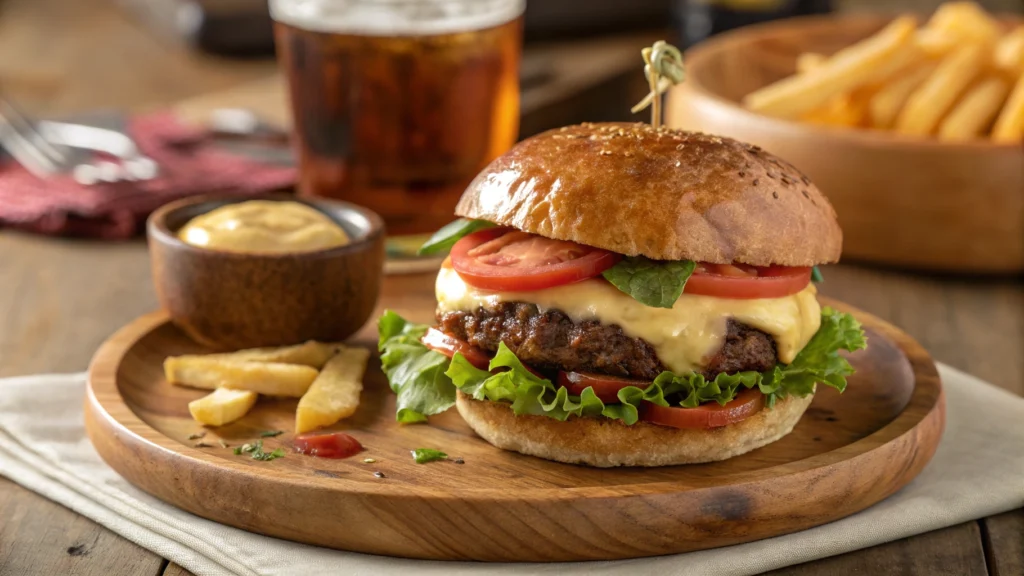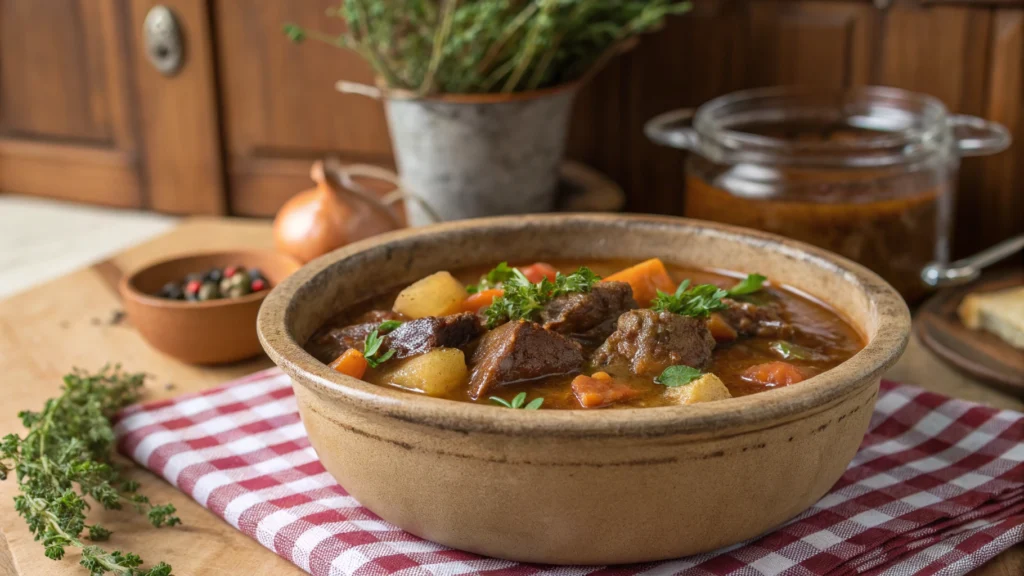The discada is loved deeply as a dish Mexican cuisine has to offer because of its brilliant taste and wide adapability. The recipe is bold and distinctive, featuring soft beef, fresh vegetables, and spices, which are skillfully combined and simmered in a cowboy-style wok. It doesn’t matter whether you have an outdoors barbecue or you want to indulge in traveling to Mexico, our guide will ensure you prepare the finest discada. When served, this dish with its layered flavors and deep, rich aromas, will become a centerpiece adored on your table for all occassions.
Table of Contents
What is a Discada?
Exploring the Basics of Discada
An integral Mexican meal loved for its uniquely juicy and smoky flavor, Discada is made in a very distinct manner. It is also called ‘Mexican stir-fry’. A “cowboy wok” or discada is a round, shallow pan used to cook it. It is made by slowly frying beef with vegetables and spices. Unlike regular stir-fry, discada is cooked on low heat for a long duration allowing all ingredients to mix together and gain plenty of flavor.
Most suitable for picnics cooking, Discada is usually made in bulk for family gatherings, barbeques, and other celebrations. It can be consumed as the main dish or as a filling on tacos. It is very versatile which makes it loved by many.
The Unique Cookware for Discada: Mexican Cowboy Wok
The unique feature that makes this dish distinctive is the discada pan (or disco). This wide flat rustic pan is carved out of used plow disks. Its shape allows for even distribution of heat and is useful in searing of meats, caramelizing of onion and cooking of several ingredients simultaneously. It helps deliver a blend of flavors and juices due to its slightly slopped edges.
Unlike a wok, designed for high scrapes or fast cooking, the discada aids in slower uncommon layered cooking allowing for depth of flavor. A cowboy wok may not be handy but a large cast iron skillet or a griddle can work but in order to maximize and undertake the authentic experience a discada pan should be used.
A Brief History: The Origin of the Mexican Discada
Traditional Roots and Regional Variations
The discada recipe has deep roots in northern Mexico, particularly in states like Chihuahua, Coahuila, and Nuevo León. It was created out of necessity by ranchers and cowboys (vaqueros) who needed a way to cook large meals while working on cattle farms. The plow discs they used for farming were repurposed into makeshift cooking pans, giving birth to the “cowboy wok” and, eventually, the dish we now know as discada.
Over time, discada evolved into a celebratory dish, often cooked for family gatherings, festivals, and outdoor barbecues. While the base recipe remains consistent—featuring beef, vegetables, and spices—each region in Mexico has its unique twist. Some versions include spicy chiles, different cuts of meat, or even beer for added depth of flavor.
The Discada’s Role in Mexican Celebrations
Discada is more than just food—it’s a social event. Cooking it is a communal experience, with family and friends gathering around the pan, sharing stories, and enjoying the aroma as the ingredients slowly meld together.
Whether served as tacos, burritos, or on a plate with rice and beans, discada represents Mexican hospitality and tradition. Today, it continues to be a staple at fiestas, weddings, and outdoor cookouts, bringing people together over a shared love of rich, smoky flavors.
Ingredients You Need for the Perfect Discada Recipe
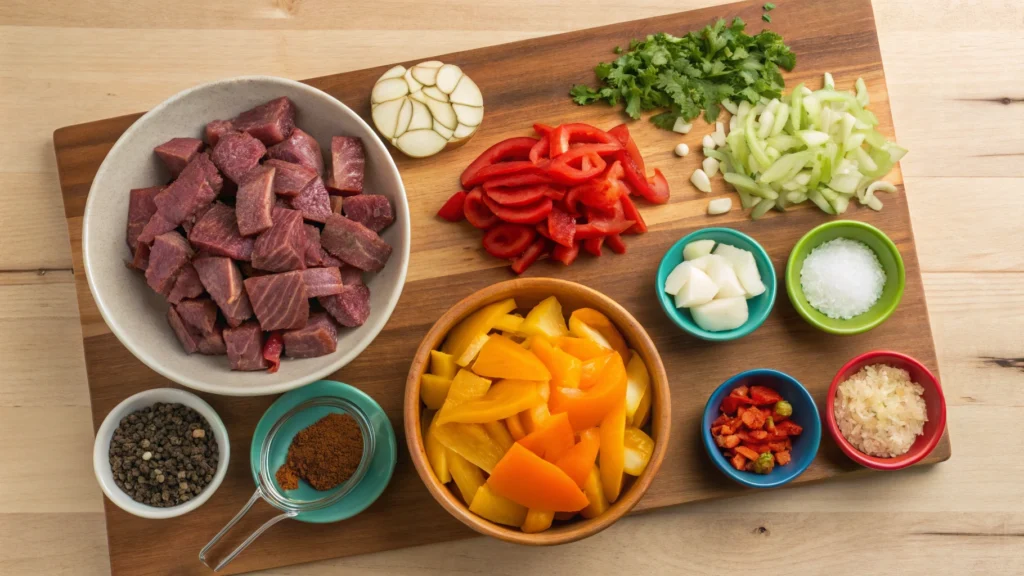
Essential Meats for Discada
Traditional discada recipes often use a mix of meats, but in this pork-free version, we’ll focus on beef-based options while still maintaining the dish’s signature depth of flavor. The best cuts of beef for discada include:
- Flank Steak or Sirloin – Lean yet flavorful, these cuts become tender when cooked slowly.
- Ground Beef – Adds a rich, juicy texture to the dish.
- Beef Sausage – A smoky, slightly spiced sausage enhances the dish’s complexity.
Using multiple cuts of beef adds layers of flavor, making the dish heartier and more satisfying.
Vegetables and Seasonings for Authentic Flavor
Vegetables play a crucial role in adding freshness, color, and sweetness to the dish. Essential ingredients include:
- Bell Peppers (Red, Green, Yellow) – Provide crunch and sweetness.
- Onions – A key ingredient that caramelizes beautifully for added depth.
- Tomatoes – Release natural juices, helping to form the rich sauce.
- Garlic – Intensifies the savory flavor.
- Jalapeños or Serranos – Optional, for those who like a spicy kick.
The Secret to Authentic Seasoning
Mexican discada seasoning is simple but essential for achieving an authentic taste:
- Cumin – Adds warmth and earthiness.
- Chili Powder – Gives a mild heat and deep color.
- Garlic Powder – Enhances the overall savoriness.
- Salt and Black Pepper – Brings out the natural flavors.
- Soy Sauce or Worcestershire Sauce – Adds umami richness.
Optional Additions to Customize Your Discada
Want to take your discada recipe to the next level? Try these optional additions:
- Mushrooms – Absorb flavors beautifully while adding a meaty texture.
- Corn – A touch of sweetness balances the dish’s smokiness.
- Cheese – Sprinkle shredded cheese on top for a Tex-Mex twist.
- Beer or Beef Broth – Used to deglaze the pan and enhance the sauce’s depth.
Pro Tip for Selecting Ingredients
For the best flavor, always use fresh, high-quality beef and vegetables. Aged spices also lose their potency over time, so ensure your seasoning is fresh for the boldest taste.
How to Prepare a Delicious Discada: Step-by-Step Guide
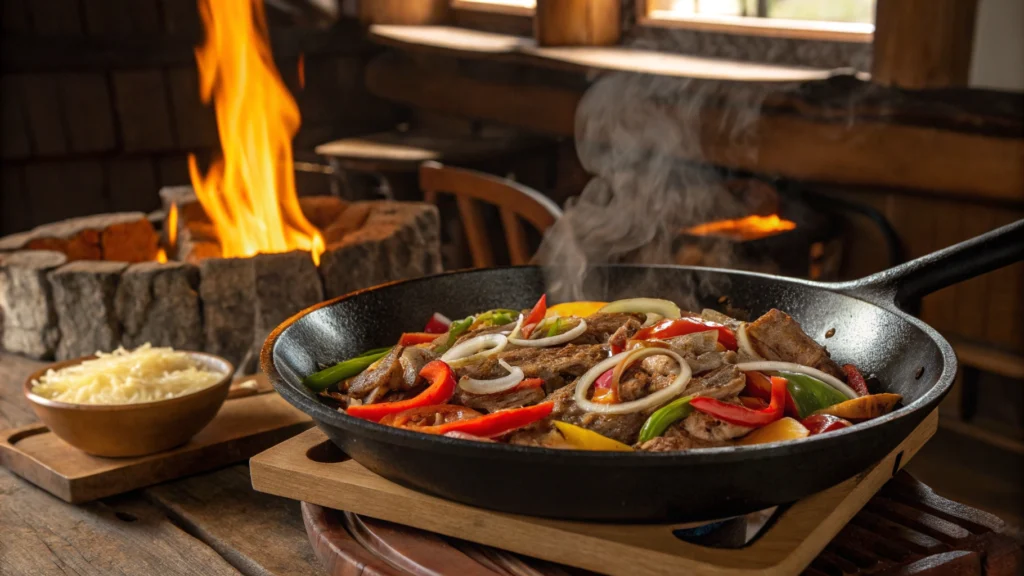
Cooking discada is all about layering flavors and letting the ingredients meld together over time. Follow these steps to create a rich, smoky, and authentic beef-based discada that’s perfect for tacos, burritos, or serving as a hearty main dish.
Prepping the Ingredients for Discada
Before you start cooking, make sure to:
- Slice the flank steak or sirloin into thin, bite-sized pieces for even cooking.
- Dice the bell peppers, onions, and tomatoes for a balanced mix of textures.
- Prepare the seasoning mix by combining cumin, chili powder, garlic powder, salt, and black pepper in a small bowl for easy access.
Layering the Ingredients: What Goes First?
The order in which ingredients are added is crucial to achieving the signature depth of flavor in discada.
Step 1: Sear the Beef
- Heat the discada pan or a large cast-iron skillet over medium-high heat.
- Add a tablespoon of oil and sear the flank steak and ground beef until browned.
- Once cooked, remove the beef and set it aside—this helps prevent overcooking.
Step 2: Caramelize the Onions and Garlic
- In the same pan, add sliced onions and garlic, cooking until they become golden and fragrant.
- Stir occasionally to prevent burning.
Step 3: Add Bell Peppers and Tomatoes
- Toss in the diced bell peppers and tomatoes, stirring occasionally.
- The tomatoes will release their juices, creating a rich base for the dish.
Step 4: Return the Meat & Season Everything
- Add the seared beef and sausage back into the pan.
- Sprinkle in the seasoning mix and stir well to ensure every ingredient is coated.
- If using beer or beef broth, pour it in now to deglaze the pan and intensify the sauce.
Step 5: Let It Simmer
- Reduce the heat to low and let everything simmer for 15–20 minutes.
- Stir occasionally to prevent sticking and allow the flavors to meld together.
Cooking Techniques: Achieving the Perfect Balance
- Don’t Rush the Cooking – The key to great discada is slow cooking, allowing the flavors to build naturally.
- Taste and Adjust – Before serving, taste the dish and adjust seasoning, spice level, or acidity with lime juice.
- Let the Sauce Thicken – If the discada looks too watery, let it cook uncovered for a few minutes until the sauce reaches the perfect consistency.
Serving Suggestions
Your discada recipe is now ready. Serve it:
With tortilla chips for a fun, shareable appetizer.
In warm corn or flour tortillas with fresh cilantro and diced onions.
Alongside Mexican rice and refried beans for a complete meal.
How to Season Your Discada for Authentic Flavor
Seasoning is the key to transforming a simple discada recipe into a dish packed with bold, authentic Mexican flavors. The right blend of spices enhances the natural taste of the beef and vegetables, creating a dish that is smoky, savory, and slightly spicy.
Traditional Seasoning Techniques
The foundation of a well-seasoned discada includes a combination of classic Mexican spices and umami-rich ingredients. Here are the essential seasonings for an authentic flavor:
- Cumin – Adds warmth and an earthy depth.
- Chili Powder – Enhances the smoky, slightly spicy notes.
- Garlic Powder – Intensifies the overall savoriness.
- Paprika – Optional, but adds a subtle smoky flavor.
- Black Pepper and Salt – Essential for balancing all flavors.
- Soy Sauce or Worcestershire Sauce – Provides a rich umami kick and helps deepen the taste.
To get the best flavor, season in layers. Start by seasoning the meat before cooking, then adjust the seasoning as the dish simmers.
Tips for Enhancing the Flavor
- Marinate the Beef – Let the flank steak sit in lime juice, soy sauce, and a sprinkle of garlic powder for at least 30 minutes before cooking. This makes the meat more tender and flavorful.
- Toast Your Spices – Before adding them to the dish, lightly toast the dry spices in the pan for a few seconds to release their essential oils and enhance their aroma.
- Deglaze the Pan – Use beer or beef broth to scrape up the browned bits at the bottom of the pan, incorporating even more flavor into the dish.
- Finish with Fresh Herbs – Garnish with fresh cilantro or parsley just before serving for a vibrant, fresh contrast to the smoky, savory discada.
Common Mistakes to Avoid
- Over-seasoning – Be mindful of the salt content, especially when using soy sauce or Worcestershire sauce.
- Skipping the Deglaze – The pan’s browned bits are packed with flavor; deglazing ensures they don’t go to waste.
- Not Letting the Flavors Develop – Simmering allows the ingredients to blend harmoniously. Rushing the process can lead to a less flavorful dish.
Sides to Pair with Discada Tacos
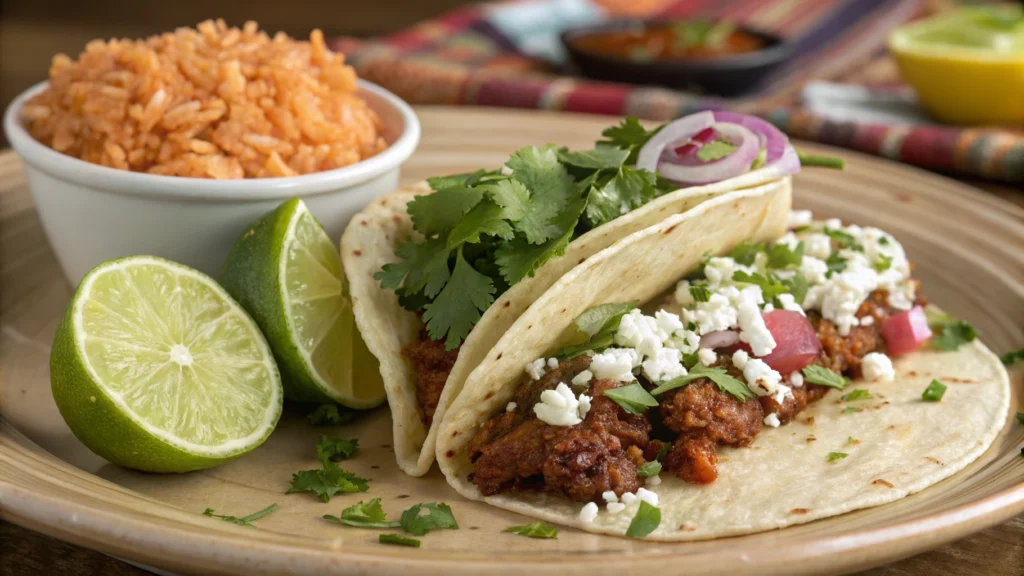
The right side dishes can elevate your discada tacos from a great meal to an unforgettable one. Whether you prefer traditional accompaniments or creative twists, these sides will perfectly complement the bold, smoky flavors of discada.
Best Sides to Complement Discada
- Mexican Rice – A flavorful side cooked with tomatoes, garlic, and spices that pairs perfectly with discada. The mild taste balances the rich, smoky notes of the dish.
- Refried Beans – Creamy and slightly salty, refried beans add a hearty contrast to the tender, juicy beef in discada tacos.
- Grilled Corn (Elote) – Corn on the cob brushed with mayonnaise, chili powder, lime juice, and crumbled cheese creates a delicious side with a sweet and smoky flavor.
- Pico de Gallo – This fresh tomato-based salsa adds a bright, zesty contrast to the rich discada. A mix of diced tomatoes, onions, cilantro, lime juice, and jalapeños brings balance to each bite.
Creative Serving Suggestions for Your Meal
- Avocado Salad – A refreshing combination of sliced avocado, red onion, and lime dressing to cleanse the palate.
- Cabbage Slaw – A light, tangy vinegar-based slaw provides a crunchy contrast to the soft tortillas and tender beef.
- Charro Beans – A flavorful Mexican bean dish cooked with tomatoes, spices, and herbs that pairs well with the smoky flavors of discada.
For a true fiesta-style meal, set up a taco bar where guests can build their own discada tacos with different toppings and sides.
Discada Variations: Unique Twists to Try
While the traditional discada recipe is packed with authentic Mexican flavors, there are several ways to customize the dish to suit different tastes and dietary preferences. Here are some unique variations to try.
Beef-Only Discada Variations
Since this version of discada is pork-free, focusing on different beef cuts and cooking techniques can create unique flavors and textures:
- Spicy Beef Discada – Add extra jalapeños, serrano peppers, or chipotle in adobo sauce for a smoky and fiery kick.
- Smoky BBQ Discada – Incorporate a splash of barbecue sauce or smoked paprika for a Tex-Mex-inspired twist.
- Cheesy Beef Discada – Sprinkle shredded cheese over the cooked discada before serving for a creamy, indulgent variation.
Vegan and Vegetarian Discada Ideas
For those who prefer a plant-based version, discada can still be just as flavorful without meat:
- Mushroom Discada – Use a mix of portobello, shiitake, or cremini mushrooms to replicate the meaty texture.
- Tofu and Vegetable Discada – Pan-fry firm tofu with bell peppers, onions, and tomatoes while keeping the traditional seasoning blend.
- Lentil Discada – Cook seasoned lentils with fresh vegetables for a protein-packed, fiber-rich alternative.
Regional Variations of Discada
Each region in Mexico has its own take on discada, often influenced by local ingredients:
- Northern Mexico Discada – Traditional beef-heavy recipes cooked with minimal seasoning to let the meat’s natural flavors shine.
- Tex-Mex Discada – Includes ingredients like beans, corn, and cheese for a fusion of Mexican and American flavors.
- Coastal Discada – Some coastal areas substitute beef with seafood like shrimp or fish, offering a completely different take on the dish.
No matter the variation, discada remains a dish that brings people together, making it the perfect meal for experimenting with new flavors.
Health Considerations: Calories and Nutritional Facts About Discada
Understanding the nutritional value of discada can help you make healthier choices while enjoying this flavorful dish. Since discada includes beef, vegetables, and seasonings, the calorie content varies depending on the cuts of meat, portion sizes, and additional toppings.
How Many Calories Are in a Discada?
On average, a one-cup serving of beef-based discada contains approximately:
- Calories: 300–400 per serving
- Protein: 25–30 grams
- Fat: 18–25 grams (varies based on meat cuts and added oil)
- Carbohydrates: 6–10 grams (mainly from vegetables)
- Fiber: 2–3 grams
If served with tortillas and toppings, the total calorie count increases:
- Corn Tortilla: 60–80 calories each
- Flour Tortilla: 140–170 calories each
- Cheese and Sour Cream: 100+ calories per serving
Balancing Indulgence with Healthier Choices
For a healthier discada, consider these tips:
- Use Lean Cuts of Beef – Opt for sirloin or flank steak instead of fattier cuts.
- Reduce Oil Usage – Limit the amount of added oil or use a non-stick pan.
- Increase Vegetable Content – Adding more bell peppers, onions, and tomatoes enhances the dish’s nutritional profile.
- Choose Corn Tortillas – They are lower in calories and carbs compared to flour tortillas.
- Skip High-Calorie Toppings – Swap sour cream and cheese for fresh salsa or avocado for a healthier alternative.
Eating discada in moderation and pairing it with nutritious sides can help maintain a balanced diet without sacrificing flavor.
Discada vs. Other Cookware: Is a Discada the Same as a Wok?
A discada pan and a wok may look similar, but their designs, cooking methods, and purposes are quite different. Understanding these differences can help you decide whether a discada pan is essential or if a wok can be used as a substitute.
Key Differences Between a Discada and a Wok
- Shape and Structure
- A discada pan is wide, shallow, and slightly concave, making it perfect for slow, even cooking.
- A wok has steep, sloping sides designed for quick stir-frying at high heat.
- Cooking Technique
- Discada cooking relies on low-to-medium heat, allowing ingredients to caramelize and develop deep flavors.
- Wok cooking is typically fast, using very high heat to sear ingredients quickly while tossing them constantly.
- Material and Heat Distribution
- Discadas are often made from repurposed plow discs, creating a durable and thick surface that retains heat well.
- Woks are usually made from thin carbon steel, which heats up and cools down quickly.
Why a Discada is Perfect for Outdoor Cooking
The discada pan is ideal for large-batch cooking and outdoor grilling. Its wide surface allows multiple ingredients to cook at once without overcrowding. The thick metal also retains heat, ensuring a steady cooking temperature over an open flame or propane burner.
Can a Wok Be Used Instead?
While a wok can be used in place of a discada in some cases, the cooking results will differ. A wok’s high-heat, fast-cooking design does not allow for the slow, caramelized layering of flavors that makes discada unique. If using a wok, cook in smaller batches and lower the heat to better replicate the discada cooking method.
FAQs About Discada
What Kind of Meat Is Discada?
Discada traditionally includes a mix of meats such as beef, sausage, and sometimes chicken. For a beef-focused discada, cuts like flank steak, sirloin, or ground beef are popular choices due to their rich flavor and tender texture.
What Goes First in a Discada?
The order of ingredients is crucial for building flavor. Generally, you start by cooking the meats like ground beef and sausage to create a flavorful base. Once the meats are browned, add onions and garlic, followed by bell peppers, tomatoes, and any other vegetables. This layering ensures every ingredient cooks perfectly without losing its texture.
What Is the Origin of the Mexican Discada?
Discada originates from northern Mexico, where cowboys, or vaqueros, used plow discs over open fires to cook their meals. Over time, this practical method evolved into the iconic dish we know today. It’s a staple in outdoor gatherings and celebrations across Mexico, especially in states like Chihuahua and Coahuila.
How to Season a Discada?
Seasoning a discada involves using a mix of spices such as cumin, garlic powder, chili powder, and paprika. Adding soy sauce, lime juice, or even beer enhances the flavors further. The key is to balance the spices so that they complement the beef and vegetables without overpowering them.
What Is Another Name for a Discada?
Discada is sometimes called a “Mexican stir-fry” due to its similarity to stir-fried dishes. The cookware, often referred to as a “cowboy wok,” is also an integral part of the dish’s identity.
What Sides Go With Discada Tacos?
Popular sides for discada tacos include Mexican rice, refried beans, grilled corn, and fresh pico de gallo. These sides complement the rich and smoky flavors of the discada while adding variety to your meal.
Is a Discada the Same as a Wok?
No, a discada is not the same as a wok. While both are versatile pans, the discada’s flat surface is better suited for grilling and slow cooking, whereas a wok’s curved design is ideal for stir-frying.
What Is a Cowboy Wok?
A cowboy wok, or disco, is a large, flat cooking pan originally made from recycled plow discs. It’s perfect for outdoor cooking over open flames and is commonly used to make dishes like discada, carne asada, and fajitas.
How Many Calories Are in Discada?
A serving of beef-based discada typically contains 300–400 calories, depending on the amount of oil and added sides. By using lean beef and loading up on vegetables, you can create a healthier version of this classic dish.
Conclusion: Bringing Authentic Discada to Your Table
Discada is more than just a dish—it’s a celebration of Mexican culture, tradition, and flavor. Whether you’re preparing it for a backyard gathering, a family dinner, or just exploring new recipes, this dish delivers a rich, smoky, and satisfying experience.
The beauty of discada lies in its versatility. By using different beef cuts, fresh vegetables, and the right blend of spices, you can create a version that suits your taste while staying true to its authentic roots. Whether served in warm tortillas, alongside rice and beans, or with fresh toppings, this dish brings people together over its bold and savory flavors.
Cooking discada also allows you to enjoy the unique cowboy wok technique, which slowly caramelizes the ingredients for deep, complex flavors. If you don’t have a traditional discada pan, a large cast-iron skillet or griddle can work as a substitute. However, for the full experience, cooking it over an open flame in a real discada is unbeatable.
Now that you have all the tips, techniques, and variations, it’s time to try this authentic discada recipe yourself. Gather your ingredients, fire up your grill, and enjoy the true taste of Mexican outdoor cooking.


